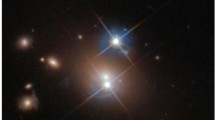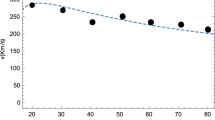Abstract
The theory of gravitational lensing of background quasars by stars in the halo of a galaxy is considered. In the limiting case of small ‘optical depth’, only one star is close enough to the beam to cause strong scattering, and the effect of all the other stars is treated as a perturbation with both systematic and random components. The perturbation coming from weak scattering can increase the number of images and the amplification in those cases where the amplification is already high; such events are preferentially selected in flux limited observations. The theory is applicable to the apparent association of background quasars with foreground galaxies. A comparison with earlier work on the same problem is given. The relevance of these results to gravitational lensing by galaxies as perturbed by random inhomogeneities surrounding the ray path is also briefly discussed.
Similar content being viewed by others
References
Avni, Y. 1981,Astrophys. J.,248, L95.
Barnothy, J. M., Barnothy, M. F. 1968,Science,162, 348.
Born, M., Wolf, E. 1975,Principles of Optics, Pergamon, New York.
Bourassa, R. R., Kantowski, R. 1975,Astrophys. J.,195, 13.
Canizares, C. R. 1981,Nature,291, 620.
Chandrasekhar, S. 1943,Rev. mod. Phys.,15, 1.
Chang, K., Refsdal, S. 1979,Nature,282, 561.
Dashevskii, V. M., Slysh, V. I. 1965,Astr. Zu.,42, 863: 1966,Soviet Astr.,9, 671.
Gott, J. R. 1981,Astrophys. J.,243, 140.
Gott, J. R., Gunn, J. E. 1974,Astrophys. J.,190, L105.
Gunn, J. E. 1967,Astrophys. J.,150, 737.
Hawking, S. W., Ellis, G. F. R. 1973,The Large Scale Structure of Space-Time, Cambridge University Press.
Kittel, C. F. 1966,Introduction to Solid State Physics, 3 edn, Wiley, New York.
Misner, C. W., Thorne, K. S., Wheeler, J. A. 1972,Gravitation, Freeman, San Francisco.
Peacock, J. A. 1982,Mon. Not. R. astr. Soc,185, 987.
Press, W. H., Gunn, J. E. 1973,Astrophys. J.,185, 397.
Refsdal, S. 1964,Mon. Not. R. astr. Soc,128, 307.
Turner, E. L. 1980,Astrophys. J.,242, L135.
Turner, E. L., Ostriker, J. P., Gott, J. R. 1984,Astrophys. J., in press (TOG).
Vietri, M., Ostriker, I. P., 1983,Astrophys. J.,267, 488(VO).
Walsh, D., Carswell, R. F., Weymann, R. J. 1979,Nature,279, 381.
Young, P. J., 1981,Astrophys. J.,244, 756.
Young, P. J., Gunn, J. E., Kristian, J., Oke, J. B., Westphal, J. A. 1981,Astrophys. J.,244, 736.
Zel’dovich, Ya. B. 1964,Astr. Zu.,41, 19: 1964,Soviet Astr.,8,13.
Author information
Authors and Affiliations
Rights and permissions
About this article
Cite this article
Nityananda, R., Ostriker, J.P. Gravitational lensing by stars in a galaxy halo: Theory of combined weak and strong scattering. J Astrophys Astron 5, 235–250 (1984). https://doi.org/10.1007/BF02714541
Issue Date:
DOI: https://doi.org/10.1007/BF02714541




